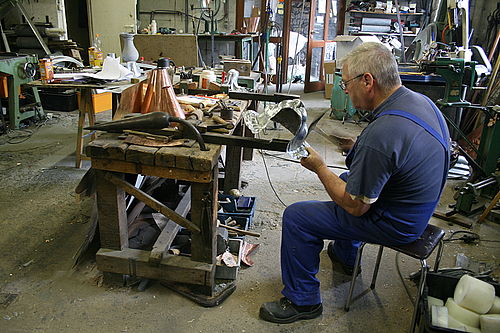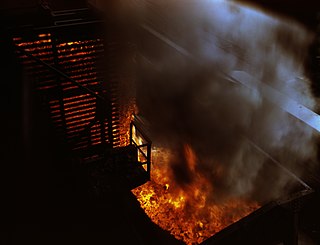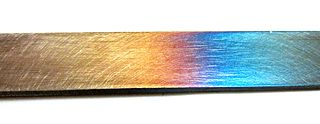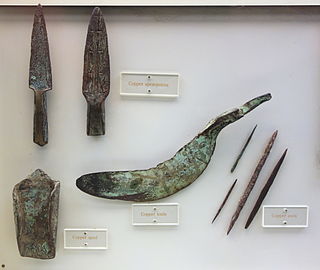

A coppersmith, also known as a brazier, is a person who makes artifacts from copper and brass. Brass is an alloy of copper and zinc. The term "redsmith" is used for a tinsmith that uses tinsmithing tools and techniques to make copper items.


A coppersmith, also known as a brazier, is a person who makes artifacts from copper and brass. Brass is an alloy of copper and zinc. The term "redsmith" is used for a tinsmith that uses tinsmithing tools and techniques to make copper items.
Anthropologists believe copper to be the first metal used by humans due to its softness and ease of manipulation. In antiquity, copper's durability and resistance to rust or corrosion proved valuable. Copper's relationship with man is thought to date back over six thousand years. [1] Coppersmith is one of the few trades that have a mention in the Bible. [2]
Copper was particularly worked in England, with ores smelted in Wales as early as the 1500s. Copper was found in great quantities in North America, especially Montana, as well as archaic copper mines near Lake Superior, which was recorded by a Jesuit missionary in 1659. [3]
Coppersmithing as a trade benefited strongly from the invention of sheet metal rollers. Copper sheet was then available in a much more versatile and easy form for creating copper wares. By the 1700s, coppersmiths lived in the American colonies, but did not have access to much sheet copper due to the British Crown's regulation of copper and other goods to the Americas. Sheet metal production was prohibited in the colonies as well before the American Revolution. [4]

Most coppersmiths can create, from a pattern, copper wares from a sheet of copper. They can also repair, clean and re-tin copper cookware interiors. Some copper smiths make barrels. Some coppersmiths will specialize in specific forms or items, such as a particular type of biscuit oven or mug or kettle. In the 1700 and 1800s, coppersmiths typically had a few apprentices in various stages of learning the trade working together.
Apprentices would start learning the trade usually around 8 or 9 years old. Typical duties of a youth in the copper shop would include tasks such as breaking coke or sal ammoniac blocks, scouring copper pieces to prepare them for tinning, and polishing hammers and tools. [5]
In regions where copper is mined like Iberia and India there are a number of centers where the coppersmith trade has flourished.
These include:

Notable copper styles in the UK include Newlyn in Cornwall and Keswick in Cumbria. Coppersmith work started waning in the late 1970s and early 1980s and those in the sheetmetal trade began doing the coppersmith's work, the practices used being similar to those in the plumbing trade. Coppersmiths in recent years have turned to pipe work, not only in copper but also stainless steel and aluminium, particularly in the aircraft industry.
Copper is generally considered to be a soft metal, meaning it can be worked without heating. Over a period of working the metal in this way it can "work-harden". This means that the atoms within the copper are compressed and irregular in their arrangement. This causes stress in the metal and eventually cracking the metal along these stress points. In order for the copper to be worked to any extensive degree it must be annealed. This process involves heating the metal and then rapidly cooling it in water. The cooling stage is known as quenching. By heating the copper, the atoms in the metal are relaxed, and thus able to align themselves in a more uniform fashion. This allows for easier shaping of the metal. In order to keep this uniformity within the metal, it is cooled rapidly. This prevents the atoms from moving around and causing tension in the structure of the metal. Unlike ferrous metals—which must be cooled slowly to anneal—copper can be cooled slowly in air or quickly by quenching in water.

An alloy is a mixture of chemical elements of which at least one is a metal. Unlike chemical compounds with metallic bases, an alloy will retain all the properties of a metal in the resulting material, such as electrical conductivity, ductility, opacity, and luster, but may have properties that differ from those of the pure metals, such as increased strength or hardness. In some cases, an alloy may reduce the overall cost of the material while preserving important properties. In other cases, the mixture imparts synergistic properties to the constituent metal elements such as corrosion resistance or mechanical strength.

Metallurgy is a domain of materials science and engineering that studies the physical and chemical behavior of metallic elements, their inter-metallic compounds, and their mixtures, which are known as alloys. Metallurgy encompasses both the science and the technology of metals; that is, the way in which science is applied to the production of metals, and the engineering of metal components used in products for both consumers and manufacturers. Metallurgy is distinct from the craft of metalworking. Metalworking relies on metallurgy in a similar manner to how medicine relies on medical science for technical advancement. A specialist practitioner of metallurgy is known as a metallurgist.

A soldering iron is a hand tool used in soldering. It supplies heat to melt solder so that it can flow into the joint between two workpieces.

Gilding metal is a form of brass with a much higher copper content than zinc content. Exact figures range from 95% copper and 5% zinc to “8 parts copper to 1 of zinc” in British Army Dress Regulations.

A blacksmith is a metalsmith who creates objects primarily from wrought iron or steel, but sometimes from other metals, by forging the metal, using tools to hammer, bend, and cut. Blacksmiths produce objects such as gates, grilles, railings, light fixtures, furniture, sculpture, tools, agricultural implements, decorative and religious items, cooking utensils, and weapons. There was an historical distinction between the heavy work of the blacksmith and the more delicate operation of a whitesmith, who usually worked in gold, silver, pewter, or the finishing steps of fine steel. The place where a blacksmith works is called variously a smithy, a forge or a blacksmith's shop.

Heat treating is a group of industrial, thermal and metalworking processes used to alter the physical, and sometimes chemical, properties of a material. The most common application is metallurgical. Heat treatments are also used in the manufacture of many other materials, such as glass. Heat treatment involves the use of heating or chilling, normally to extreme temperatures, to achieve the desired result such as hardening or softening of a material. Heat treatment techniques include annealing, case hardening, precipitation strengthening, tempering, carburizing, normalizing and quenching. Although the term heat treatment applies only to processes where the heating and cooling are done for the specific purpose of altering properties intentionally, heating and cooling often occur incidentally during other manufacturing processes such as hot forming or welding.

Austenite, also known as gamma-phase iron (γ-Fe), is a metallic, non-magnetic allotrope of iron or a solid solution of iron with an alloying element. In plain-carbon steel, austenite exists above the critical eutectoid temperature of 1000 K (727 °C); other alloys of steel have different eutectoid temperatures. The austenite allotrope is named after Sir William Chandler Roberts-Austen (1843–1902); it exists at room temperature in some stainless steels due to the presence of nickel stabilizing the austenite at lower temperatures.

Cookware and bakeware is food preparation equipment, such as cooking pots, pans, baking sheets etc. used in kitchens. Cookware is used on a stove or range cooktop, while bakeware is used in an oven. Some utensils are considered both cookware and bakeware.

Metalworking is the process of shaping and reshaping metals to create useful objects, parts, assemblies, and large scale structures. As a term it covers a wide and diverse range of processes, skills, and tools for producing objects on every scale: from huge ships, buildings, and bridges down to precise engine parts and delicate jewelry.

Carbon steel is a steel with carbon content from about 0.05 up to 2.1 percent by weight. The definition of carbon steel from the American Iron and Steel Institute (AISI) states:

In materials science, quenching is the rapid cooling of a workpiece in water, oil, polymer, air, or other fluids to obtain certain material properties. A type of heat treating, quenching prevents undesired low-temperature processes, such as phase transformations, from occurring. It does this by reducing the window of time during which these undesired reactions are both thermodynamically favorable, and kinetically accessible; for instance, quenching can reduce the crystal grain size of both metallic and plastic materials, increasing their hardness.

Induction cooking is performed on an electric stove using direct induction heating of cooking vessels, rather than relying on indirect radiation, convection, or thermal conduction. Induction cooking allows high power and very rapid increases in temperature to be achieved: changes in heat settings are instantaneous.

In materials science, work hardening, also known as strain hardening, is the strengthening of a metal or polymer by plastic deformation. Work hardening may be desirable, undesirable, or inconsequential, depending on the context.

Tempering is a process of heat treating, which is used to increase the toughness of iron-based alloys. Tempering is usually performed after hardening, to reduce some of the excess hardness, and is done by heating the metal to some temperature below the critical point for a certain period of time, then allowing it to cool in still air. The exact temperature determines the amount of hardness removed, and depends on both the specific composition of the alloy and on the desired properties in the finished product. For instance, very hard tools are often tempered at low temperatures, while springs are tempered at much higher temperatures.

A metalsmith or simply smith is a craftsperson fashioning useful items out of various metals. Smithing is one of the oldest metalworking occupations. Shaping metal with a hammer (forging) is the archetypical component of smithing. Often the hammering is done while the metal is hot, having been heated in a forge. Smithing can also involve the other aspects of metalworking, such as refining metals from their ores, casting it into shapes (founding), and filing to shape and size.

A tinsmith is a person who makes and repairs things made of tin or other light metals. The profession may sometimes also be known as a tinner, tinker, tinman, or tinplate worker; whitesmith may also refer to this profession, though the same word may also refer to an unrelated specialty of iron-smithing. By extension it can also refer to the person who deals in tinware, or tin plate. Tinsmith was a common occupation in pre-industrial times.

A reactor pressure vessel (RPV) in a nuclear power plant is the pressure vessel containing the nuclear reactor coolant, core shroud, and the reactor core.

In materials science, intergranular corrosion (IGC), also known as intergranular attack (IGA), is a form of corrosion where the boundaries of crystallites of the material are more susceptible to corrosion than their insides.
In metallurgy and materials science, annealing is a heat treatment that alters the physical and sometimes chemical properties of a material to increase its ductility and reduce its hardness, making it more workable. It involves heating a material above its recrystallization temperature, maintaining a suitable temperature for an appropriate amount of time and then cooling.

The Old Copper complex or Old Copper culture is an archaeological culture from the Archaic period of North America's Great Lakes region. Artifacts from some of these sites have been dated from 7500 to 1000 BCE. It is characterized by widespread copper artifacts, including tools and weapons, as well as ornamental objects. The archeological evidence of smelting or alloying is subject to some dispute, and it is commonly believed that objects were cold-worked into shape. Furthermore, some archaeologists are convinced by the artifactual and structural evidence for metal casting by Hopewellian and Mississippian peoples.